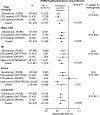Diet, cardiovascular disease, and mortality in 80 countries
- PMID: 37414411
- PMCID: PMC10361015
- DOI: 10.1093/eurheartj/ehad269
Diet, cardiovascular disease, and mortality in 80 countries
Abstract
Aims: To develop a healthy diet score that is associated with health outcomes and is globally applicable using data from the Prospective Urban Rural Epidemiology (PURE) study and replicate it in five independent studies on a total of 245 000 people from 80 countries.
Methods and results: A healthy diet score was developed in 147 642 people from the general population, from 21 countries in the PURE study, and the consistency of the associations of the score with events was examined in five large independent studies from 70 countries. The healthy diet score was developed based on six foods each of which has been associated with a significantly lower risk of mortality [i.e. fruit, vegetables, nuts, legumes, fish, and dairy (mainly whole-fat); range of scores, 0-6]. The main outcome measures were all-cause mortality and major cardiovascular events [cardiovascular disease (CVD)]. During a median follow-up of 9.3 years in PURE, compared with a diet score of ≤1 points, a diet score of ≥5 points was associated with a lower risk of mortality [hazard ratio (HR) 0.70; 95% confidence interval (CI) 0.63-0.77)], CVD (HR 0.82; 0.75-0.91), myocardial infarction (HR 0.86; 0.75-0.99), and stroke (HR 0.81; 0.71-0.93). In three independent studies in vascular patients, similar results were found, with a higher diet score being associated with lower mortality (HR 0.73; 0.66-0.81), CVD (HR 0.79; 0.72-0.87), myocardial infarction (HR 0.85; 0.71-0.99), and a non-statistically significant lower risk of stroke (HR 0.87; 0.73-1.03). Additionally, in two case-control studies, a higher diet score was associated with lower first myocardial infarction [odds ratio (OR) 0.72; 0.65-0.80] and stroke (OR 0.57; 0.50-0.65). A higher diet score was associated with a significantly lower risk of death or CVD in regions with lower than with higher gross national incomes (P for heterogeneity <0.0001). The PURE score showed slightly stronger associations with death or CVD than several other common diet scores (P < 0.001 for each comparison).
Conclusion: A diet comprised of higher amounts of fruit, vegetables, nuts, legumes, fish, and whole-fat dairy is associated with lower CVD and mortality in all world regions, especially in countries with lower income where consumption of these foods is low.
Keywords: Cardiovascular events; Diet quality; Dietary patterns; Diverse populations; Global; Mortality.
© The Author(s) 2023. Published by Oxford University Press on behalf of the European Society of Cardiology.
Conflict of interest statement
Conflict of interest All authors have completed the ICMJE uniform disclosure form at www.icmje.org/coi_disclosure.pdf and declare: no support from any additional organization for the submitted work. A detailed list of funders is provided in the Supplementary data online, Appendix. The authors have no financial relationships with any organizations, or other relationships or activities that might have influenced the submitted work in the previous 3 years.
Figures








Comment in
-
Identifying nutritional priorities for global health: time for a more PURE focus on protective foods.Eur Heart J. 2023 Jul 21;44(28):2580-2582. doi: 10.1093/eurheartj/ehad325. Eur Heart J. 2023. PMID: 37414412 Free PMC article.
References
-
- Dietary Guidelines Advisory Committee . Scientific Report of the 2015 Dietary Guidelines Advisory Committee. 2015. http://www.health.gov/dietaryguidelines/2015-scientific-report/. Accessed 12 Nov 2019.
-
- Micha R, Shulkin ML, Peñalvo JL, Khatibzadeh S, Singh GM, Rao M, et al. Etiologic effects and optimal intakes of foods and nutrients for risk of cardiovascular diseases and diabetes: systematic reviews and meta-analyses from the nutrition and chronic diseases expert group (NutriCoDE). PLoS One 2017;12:e0175149. 10.1371/journal.pone.0175149 - DOI - PMC - PubMed
Publication types
MeSH terms
Grants and funding
LinkOut - more resources
Full Text Sources
Medical

